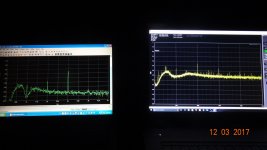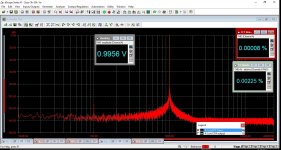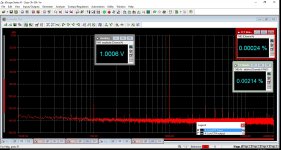Scott download this zip.
I've playing around with PortAudio today and managed to compile one of the examples in Visual Studio. This app gathers information about all the audio drivers on your win machine and displays the capabilities of each driver.
Some driver won't show up unless the device, (sound card), is connected.
Port Audio is capable of opening an audio stream from any of the audio APIs including ASIO. We can do what ever we want with the stream.
It's also C# friendly which what I like to code in. PortAudio API is written in C and compiles to a dll.
The example is a COM executable. You have to run it from a shell, CMD will do. The .exe file must be run in the same directory as the .dll.
I've playing around with PortAudio today and managed to compile one of the examples in Visual Studio. This app gathers information about all the audio drivers on your win machine and displays the capabilities of each driver.
Some driver won't show up unless the device, (sound card), is connected.
Port Audio is capable of opening an audio stream from any of the audio APIs including ASIO. We can do what ever we want with the stream.
It's also C# friendly which what I like to code in. PortAudio API is written in C and compiles to a dll.
The example is a COM executable. You have to run it from a shell, CMD will do. The .exe file must be run in the same directory as the .dll.
Attachments
Off topic, speaking of deals, https://www.arrow.com/en/products/eco-s1ka152ca/panasonic
I got 100 pcs. @50p and free shipping to the UK, for you yanks they are 60 cents a pop, go get them before they are gone. Unbelievable deal for this now obsolete part, digikey used to charge $4 a pop when it was current.
At this kind of pricing, even yours truly could go into building amplifiers as a hobby .
.
I got 100 pcs. @50p and free shipping to the UK, for you yanks they are 60 cents a pop, go get them before they are gone. Unbelievable deal for this now obsolete part, digikey used to charge $4 a pop when it was current.
At this kind of pricing, even yours truly could go into building amplifiers as a hobby
Last edited:
It takes some effort to call these expensive toys "DSOs". In particular after trying to get some triggering beyond the very basic. Oh, and sampling rates are (for the Cleverscope) "100 MSamples/s to 1500 MSamples/s" guess the sample rate of the 14bit version and the single shot capability.
On the same note, ARTA plus a decent sound card can be viewed as a 24bit almost 100KHz bandwidth DSO. Not bad for 50 quid.
I know nothing about the cleverscope but the Picoscope stuff has been as good as any of the big stuff (Tek, Keysight) I have tried in similar performance ranges.
The USB interface makes for different interaction but it does the same DPO stuff. FWIW I still use Tek 7K stuff for serious troubleshooting and a Tek DSA8200 for high speed work.
I know nothing about the cleverscope but the Picoscope stuff has been as good as any of the big stuff (Tek, Keysight) I have tried in similar performance ranges.
Really, was there a Tektronix or Keysight 5MHz DSO in the last 30 years?
Googling Data Acquisition shows a lot of choises and prices and I am sure most of it works perfectly.... compared to typical Windows 3rd party HW/SW.
meanwhile, Here is the trouble I described in words before about the 2H and 3H measurement at low (<-130dbv) are not the same or even close with well known brands......
Here is AP 2722 and ShibaSoku 725D both measuring the same signal - T'ed to an AP and other to 725D-Qa401. never mind the scale differences..... look at the 2H and 3H are opposite in level to each instrument.
??
So after you get thru the T&M instrumentation -- hardware and software.... do they all show same data for 2H and 3H at ultra low distortion levels !?

THx-RNMarsh
meanwhile, Here is the trouble I described in words before about the 2H and 3H measurement at low (<-130dbv) are not the same or even close with well known brands......
Here is AP 2722 and ShibaSoku 725D both measuring the same signal - T'ed to an AP and other to 725D-Qa401. never mind the scale differences..... look at the 2H and 3H are opposite in level to each instrument.
??
So after you get thru the T&M instrumentation -- hardware and software.... do they all show same data for 2H and 3H at ultra low distortion levels !?

THx-RNMarsh
Last edited:
Hi Richard,
The AP looks like its filters have sharper slopes or more "bins".
As far as comparisons go at those low levels, I doubt they could show the same levels. Even differences in input impedance, and I'm talking minor capacitance / inductance differences would show up. How does one differentiate between the instrument and the reality of the signal? Together they make up a system that's operating at the edges of performance limits.
I guess that's another way of saying that experimental error here is large compared to the results you're getting.
-Chris
The AP looks like its filters have sharper slopes or more "bins".
As far as comparisons go at those low levels, I doubt they could show the same levels. Even differences in input impedance, and I'm talking minor capacitance / inductance differences would show up. How does one differentiate between the instrument and the reality of the signal? Together they make up a system that's operating at the edges of performance limits.
I guess that's another way of saying that experimental error here is large compared to the results you're getting.
-Chris
Nor a 16 bit DSO. Its a niche product for specific applications. Same for a Tek DSA8200. You could not use it for any audio or normal digital applications but its not a toy.Really, was there a Tektronix or Keysight 5MHz DSO in the last 30 years?
Sent from my LG-H811 using Tapatalk
Nor a 16 bit DSO. Its a niche product for specific applications. Same for a Tek DSA8200. You could not use it for any audio or normal digital applications but its not a toy.
I guess I'm missing something here, about how does a picoscope compare to a DSA8200, both in performance and scope. To me, if it's a niche product for specific application, then it is not a DSO, but let's agree to disagree.
Hi Richard,
I guess that's another way of saying that experimental error here is large compared to the results you're getting.
-Chris
One gen tee-ed off to input of AP and input to ShibaSoku. Same coax type and lengths.
It doesn't matter what the input Z's are-- change at will. DUT distortion isn't affected by subtle changes in L, R or C at analyzer input.
This resulting pattern of low 2H and high 3H on AP persists. test with Panasonic and you get opposite... like the 725D shows.
So.... on the Sound Card type measurments, one may get low level distortion data but it must be accurate data.
THx-RNMarsh
Last edited:
Cleverscope?
TiePie's Handyscope goes to 16bit depending on bandwidth.
Jan
Scott download this zip.
I've playing around with PortAudio today and managed to compile one of the examples in Visual Studio. This app gathers information about all the audio drivers on your win machine and displays the capabilities of each driver.
Some driver won't show up unless the device, (sound card), is connected.
Port Audio is capable of opening an audio stream from any of the audio APIs including ASIO. We can do what ever we want with the stream.
It's also C# friendly which what I like to code in. PortAudio API is written in C and compiles to a dll.
The example is a COM executable. You have to run it from a shell, CMD will do. The .exe file must be run in the same directory as the .dll.
That would be new most of the open source software uses PortAudio and it does/did not support ASIO, but they have been bugged about this for several years. Current build of Audacity uses PortAudio and does not show it, while ARTA asks if you want ASIO and it works. I will check, BTW I have also run across SW that supports ASIO out only.
EDIT - Doesn't start. has VS .dll dependencies. Keep me informed if you get any more info, I only use Mingw (gcc for Windows).
Last edited:
That would be new most of the open source software uses PortAudio and it does/did not support ASIO, but they have been bugged about this for several years. Current build of Audacity uses PortAudio and does not show it, while ARTA asks if you want ASIO and it works. I will check, BTW I have also run across SW that supports ASIO out only.
EDIT - Doesn't start. has VS .dll dependencies. Keep me informed if you get any more info, I only use Mingw (gcc for Windows).
Worked on win 10 just fine.
I'll try some other compiler options. Listed all the asio drives on my machine. Very dated ones.
Can you send me some details of the dependencies?
The ASIO API had to be loaded when building the dll.
Point is if we have access to asio then we can just build our own software and have what ever we want.
I'm game.
PM me.
Yes it is a new version. The latest.
Last edited:
Worked on win 10 just fine.
I'll try some other compiler options. Listed all the asio drives on my machine. Very dated ones.
Yes it is a new version. The latest.
I added an edit it asks for a VS studio .dll and terminates.
I added an edit it asks for a VS studio .dll and terminates.
Darn. I was sure I had CLR turned off.
I'll post it.
Hi Richard,
Interesting application note. I can't say as I'm very surprised with the points made. I have called them to gain access to their other application notes. That app. note read more like a "White paper".
I usually test a pair of instruments the same way so that they do see the same input signal. However, at those low levels for noise, I'd say that the measurement uncertainties need to be identified. Except for the intended signal, all the rest (harmonics) are so close to the noise floor that tiny errors would be a large percentage compared to the signals being compared. By definition, you are at the limits of that equipment's capability and your signals are in the grass. That being said, the AP measurement suite is showing a trend that the other instruments are not. What would be really interesting to know is if another AP of the same model would show the same results. Do you think that the folks at AP would run these tests on that oscillator and send you the results? They might even agree to check it on their most cutting edge equipment that they are developing. For a manufacturer, that has some value. This would then give you confidence that your equipment is showing you the truth.
Another plan. Contact Keysight to demo their new U8903B and see what that shows. It is exactly what Keysight wants, a direct comparison using a challenging signal source. I'm pretty sure they have purchased an AP product and tested it against their own products already.
-Chris
Interesting application note. I can't say as I'm very surprised with the points made. I have called them to gain access to their other application notes. That app. note read more like a "White paper".
I usually test a pair of instruments the same way so that they do see the same input signal. However, at those low levels for noise, I'd say that the measurement uncertainties need to be identified. Except for the intended signal, all the rest (harmonics) are so close to the noise floor that tiny errors would be a large percentage compared to the signals being compared. By definition, you are at the limits of that equipment's capability and your signals are in the grass. That being said, the AP measurement suite is showing a trend that the other instruments are not. What would be really interesting to know is if another AP of the same model would show the same results. Do you think that the folks at AP would run these tests on that oscillator and send you the results? They might even agree to check it on their most cutting edge equipment that they are developing. For a manufacturer, that has some value. This would then give you confidence that your equipment is showing you the truth.
Another plan. Contact Keysight to demo their new U8903B and see what that shows. It is exactly what Keysight wants, a direct comparison using a challenging signal source. I'm pretty sure they have purchased an AP product and tested it against their own products already.
-Chris
Oops, my bad.
Here is the link;
http://www.diyaudio.com/forums/blogs/synctronx/1383-hp-339a-mods-upgrades.html
Hope this helps.
Brilliant - thanks
- Home
- Design & Build
- Equipment & Tools
- Low-distortion Audio-range Oscillator

